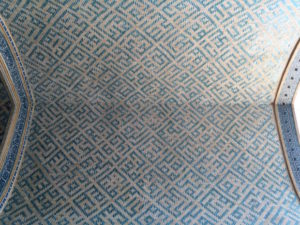
Islamic art, because it relies heavily on geometric patterns, is a rich source of designs ideas and patterns for needlepoint. It’s one you have probably overlooked largely because the curvy lines of Arabic don’t look like they would adapt well to our grid-based art. But if you look beyond calligraphy and consider mosaics and architecture, you’ll discover a world of great patterns.
In fact the very first needlepoint adaptation I did, back in High School, was a translation of a lovely Islamic mosaic. It had a white background with decorations in pink, turquoise, and olive. It was so beautiful I had to stitch it.
Two Kinds of Geometry
When you are going to translate Islamic motifs into needlepoint, your first step will need to be to determine the type of geometry used. There are two kinds: pixelated (square) and isometric (triangular). Your needlepoint approach will be different for each.
If the design is isometric, it will have lots of triangles, six-pointed stars, and hexagons.
Pixelated designs are based on square tile patterns. They even include squared off versions of Arabic calligraphy. This is an area of design that is new to me. An article from MAKE looks at these patterns in depth. The article, with stunning photos, consider the tiles as pixels. But we know that pixels can translate to stitches.
Translating Mosaics to Needlepoint
Isometric Designs: These designs can be transferred to isometric graph paper. To translate this to needlepoint, each triangle on the paper becomes one triangle in Trianglepoint. In Sherlee Lantz’ book on the subject, there are several designs that are based on Islamic patterns.
This technique is very easy to stitch and creates, I think the best isometric needlepoint.
Pixelated Designs: Get translated by making one stitch for each pixel (learn how to do it in this post) or square tile. Where you find longer tiles or bigger squares, divide them up into the smallest base unit. You can use a piece of graph paper to draw out the design until you can easily recognize the square units.
Once you’ve translated your design, think about how to use it. Will it make a great stand-alone project? Could it be the basis for an ornament or mini-sock? Could it be a lovely patterned background.
Remember the world is full of lovely patterns just waiting to be adapted to needlepoint.
About Janet M Perry
Janet Perry is the Internet's leading authority on needlepoint. She designs, teaches and writes, getting raves from her fans for her innovative techniques, extensive knowledge and generous teaching style. A leading writer of stitch guides, she blogs here and lives on an island in the northeast corner of the SF Bay with her family

Leave a Reply